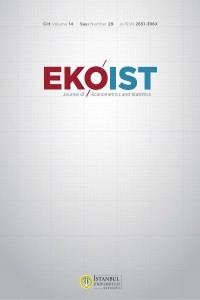ERKEN UYARI SİSTEMLERİ YOLUYLA TÜRKİYE’DEKİ EKONOMİK KRİZLERİN ANALİZİ
Ekonomik krizler, Para-ödemeler bilançosu krizleri, Finansal-bankacılık krizleri, Erken uyarı sistemleri, Döviz kuru baskı indeksi, Türkiye ekonomisi, Logit model, Probit model
___
- Adam, Christoper, Benno Ndulu and Nii Kwaku Sowa (1996) “Liberalization and Signorage Revenue in Kenya, Ghana and Tanzania”, The Journal of Development Studies, 32(4), 531-553.
- Berg, Andrew and Catherine Pattillo (1999) “Predicting Currency Crises: The Indicators Approach and an Alternative,” Journal of International Money and Finance, 18(4), 561-586.
- Calvo, Guillermo A., Carmen M. Reinhart and Carlos A. Vegh (1995) “Targeting the Real Excahnge Rate: Theory and Evidence”, Journal of Development Economics, 47, 97-133.
- Chang, Roberto and Andres Velasco (2000) “Banks, Debt Maturity and Fiancial Crises”, Journal of International Economics, 51, 169-194.
- Connolly, Michael B. and Dean Taylor (1984) “The Ecact-timing of the Collapse of an Exchange Rate Regime and its Impact on the Relative Price of Traded Goods”, Journal of Money, Credit, and Banking, 16(2), 194-207.
- Diaz-Alejandro, Carlos (1985) “Good-bye Financial Repression, Hello Financial Crash”, Journal of Development Economics, 19, 1-24.
- Dooley, Michael P., 2000, “Can Output Losses Following International Fiancial Crises Be Avoided?”, Natioanl Bureau of Economic Reserch, NBER Working Paper Series, Working Paper 7531, February 2000.
- Edin, Per-Anders and Andres Vredin (1993) “Devalusation Risk in Target Zones: Evidence from the Nordric Countries”, Economic Journal, 103, 161-175.
- Edison, J. Edison, 2000, “Do Indicators of Financial Crises Work? An Evaluation of an Early Warning Systems” Board of Governors of the Federal Reserve System, International Finance Discussion Papers, Number 675, July 2000, (http://papers.ssrn.com/sol3/Delivery.cfm/000802352.pdf?abstractid=238249&mirid=1) (November 2004).
- Edwards, Sebastian and Peter J. Montiel, 1989, “Devaluation Crises and the Macroeconomic Consequnces of Postponed Adjustment in Developing Countries”, Staff Papers, International Monetary Found, 36, 875-903.
- Eichengreen, Barry, Andrew Rose, and Charles Wyplosz, 1994, “Speculative Attacks on Pegged Exchange Rates: An Empirical Exploration with Special Reference to the European Monetary System”, NBER Working Paper No. 4898, Cambridge, National Bureau of Economic Research.
- Eichengreen, Barry, Andrew Rose, and Charles Wyplosz (1995) “Exchange Market Mayhem: The Antecedents and Aftermath of Speculative Attacks”, Economic Policy, October, 249-312. http://faculty.haas.berkeley.edu/arose/ERW3EP.pdf
- Eichengreen, Barry, Andrew Rose, and Charles Wyplosz, 1996, “Contagious Currency Crises”, NBER Working Paper No. 5681, Cambridge, National Bureau of Economic Research.
- Flood, Robert P., Peter M. Garber and Charles Kramer (1996) “Collapsing Exchange Regimes: Another Linear Example”, Journal of Internatioanl Economics, 41, 223-234.
- Frankel, Jeffrey A. and Andrew K. Rose (1996) “Currency Crashes in Emerging Markets: An Empirical Treatment”, Journal of International Economics, 41, 351-366.
- Goldberg, Linda S. (1994) “Predicting Exchange Rate Crises Mexico Revisited”, Journal of International Economics, 36(3-4), 413-430.
- Gujarati, Damodar N., 1995, Basic Econometrics, Third Edition, McGraw-Hill, New York.
- Jooesten, Wink, 2004, “The Asian Financial Crisis in Retrospect: What Happened? What Can We Conclude?”, CPB Netherlands Bureau for Economic Policy Analysis, No. 87, CBP Memorendum.
- Kamin, Steven B. And John H. Rogers (1996) “Monetary Policy in the End-game to Exchange Rate Based Stabilizations: The Case of Mexico”, Journal of International Economics, 41, 285- 307.
- Kaminsky, Graciela L., and Carmen M. Reinhart (1999) “The Twin Crises: The Causes of Banking and Balance of Payments Problems,” The American Economic Review, 89(3), 473-500.
- Kaminsky, Graciela L., Saul Lizondo and Carmen M. Reinhart, 1998, “Leading Indicators of Currency Crises”, International Monetary Fund Staff Papers. Vol 5, No 1.
- Kaminsky, Graciela L. and Leonardo Leiderman (1998) “High Real Interest Rates in the Aftermath of Disinflation: Is It a Lack of Credibility?”, Journal of Development Economics, 55, 191- 214.
- Krugman, Paul (1979) “A Model of Balance-of-Payments Crises”, Journal of Money, Credit, and Banking, 11(3), 311-325.
- Kumhof, Michael (2000) “A Quantitative Exploration of the Role of Short-term Domestic Debt in Balance of Payments Crises”, Journal of International Economics, 51, 195-215.
- Lahiri, Amartya (2000) “Disinflation Programs and Policy Uncertainty”, Journal of International Economics, 50, 351-373.
- Manasse, Paolo, Nouriel Roubini and Axel Schimmelpfennig 2003, “Predicting Sovereign Debt Crises”, IMF Working Paper/02/221, November.
- Mendoza, Enrique G. (1991) “Real Business Cycles in a Small Open Economy”, The American Economic Review, 81(4), 797-818.
- Obstfeld, Maurice (1996) “Models of Currency Crises with Self-fulfilling Features”, European Economic Review, 40, 1037-1047.
- Öniş, Ziya (2004) “The Varieties and Crises of Neo-Liberal Globalizaion: Argentina, Turkey and the IMF Nexus”, (Submitted for Publication), http://home.ku.edu.tr/~zonis/Argentina.pdf (December 2004).
- Patinkin, Don (1993) “Israle’s Stabilization Program of 1985, or Some Simple Truths of Monetary Theory”, Journal of Economic Perspectives, 7(2), 103-128.
- Reinhart, Carmen M. And Carlos A. Vegh (1995) “Nominal Interest Rates, Consumption Booms, and Lack of Credibility: A Quantitative Examination”, Journal of Development Economics, 46, 357-378.
- Tornell, Aaron (2002) “Economic Crises and Reform in Mexico”, Crony Capitalism and Economic Growth in Latin America: Theory and Evidence, Ed. Stephen Haber, Hoover Institution, 2002, 127-150. (http://www.hoover.stanford.edu/pablicationsy/books/fulltext/crony/127.pdf) (November 2004).
- Velasco, Andres (1987) “Financial and Balance of Payments Crises: A Simple Model of the Southern Cone Experience” Journal of Development Economics, 27, 263-283.
- Wolf, Charles Jr. (1999) “Markets, Not Architects, Will Solve Economic Crises” Wall Street Journal, 20 July 1999. (http://www.imfsite.org/reform/wolf.html) (November 2004).
- World Development Report 2000/2001, Managing Economic Crises and Natural Disasters, (http://www.worldbank.org/poverty/wdrpoverty/report/ch11.pdf) (July 2004).
- Yayın Aralığı: Yılda 2 Sayı
- Yayıncı: İstanbul Üniversitesi
ERKEN UYARI SİSTEMLERİ YOLUYLA TÜRKİYE’DEKİ EKONOMİK KRİZLERİN ANALİZİ
Prof.dr. Cevat GERNİ, Doç.dr. Ö. Selçuk EMSEN, Yrd.doç.dr. M. Kemal DEĞER
TÜRKİYE EKONOMİSİNDE BÜYÜME İLE İŞSİZLİK ORANLARI ARASINDAKİ NEDENSELLİK İLİŞKİSİ
TOPLAM FİYAT-SEVİYE ESNEKLİĞİ VE ARZYANLI ŞOKLAR İLE İLGİLİ BİR ÇALIŞMA
